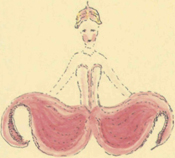
The soft, azure, star-like blooms of the periwinkle give the only color to be found in the shady recesses of the hillside below my garden. Even on the darkest California winter day I can usually depend on this faithful bloomer to enliven my herbal bouquets with a dash of quiet blue.
Over the years, I’ve asked flower lovers all over the United States and Britain for legends and lore about the humble periwinkle, but always to no avail. Sometimes we tend to overlook what’s right under our noses. Such was the case with periwinkles and my friend Margaret Harper.
Margaret arrived one day smiling impishly, carrying a small bouquet of periwinkles. “Do you know the story of Perry Winkle’s Paintbrush?” she asked. “It was told to me by Rossie Fairbairn. Her mother, Isabelle Evans, of Blue Lake, California, kept Rossie entertained when she was a child with stories of the wonders of plant life. Now, I share the story with my grandchildren, who never tire of it or of the search for the paintbrush.”
Margaret set her bouquet down on a table and pulled out a single stem in bloom. As she began telling the story, she carefully and slowly removed petal after petal.
Sometimes we
•
tend to overlook
•
what’s right
•
under our noses
•
Such was the case
•
with periwinkles

The first Spring descended upon the earth, and all of the new, young animals and shimmering green plants and trees were healthy and happy. The view from a hilltop across mile after mile of wildflowers with all different blossom and leaf shapes revealed one startling, glaringly obvious thing. Somehow, the finishing touch had been overlooked! All the flowers were one color—WHITE!
The very last flower to have been created was the humble periwinkle. Thus, he was the one called upon to solve the problem of coloring all of the flowers.
“Goodness, gracious,” said Perry in a small, blue voice. “I am depressed. There is just no way a little flower like me could color all the flowers in the world.”
“Perry,” a deep, soft voice resounded, “what you need is a little faith! In this world everyone has a job and is expected to work. The job for you and your family will be to paint all the flowers every color to be found on our earth and in our sky.”
“But how can I do such a thing? There are not enough brushes or paint in the world to color the millions of flowers you have strewn on this planet,” Perry said in a defeated tone.
“The rainbow will be your never-ending supply of colors. And listen closely: Slip your petals off, and you will see that I have given every periwinkle in my kingdom its very own paintbrush.”
As Margaret ended her story, she slipped off the last pale blue petal and pulled out the tiniest, most fairy-like paintbrush I have ever seen. Since that day with Margaret, I have introduced dozens of children to the magical, hidden secret of the often-overlooked periwinkle.

Nikolai Reimer was a nurseryman and plant lover who grew up in Czarist Russia and emigrated to Canada. His daughters Mary and Frieda say, “In the beginning, our father neither understood nor spoke the English language, but he was an expert in the universal language of flowers.” Nikolai founded the now well-known Reimer’s Nursery in Yarrow, British Columbia. When people in the area suggested that he spend more time growing fruit trees and other useful plants—plants that would provide food to eat—he would say, “When God created humankind, he gave each person two eyes, but only one mouth. Two eyes to appreciate doubly the beauty around us.” He propagated great numbers of trees and shrubs, but flowers remained his first love.
“Our father taught us many things about plants and flowers,” say Frieda and Mary. “Among them was the story of the Stiefmutterchen (German for Little Stepmother, better known as the pansy). He would pick a pansy, and handling it with care so as not to injure its delicate beauty, proceed to introduce us to the little stepmother and her family”: “Today our father is 95 years old. He can no longer see the beauty of a flower. Recently we asked him if he would like to relive his life. ‘Oh yes,’ was the answer, ‘if I could again be a gardener.’”
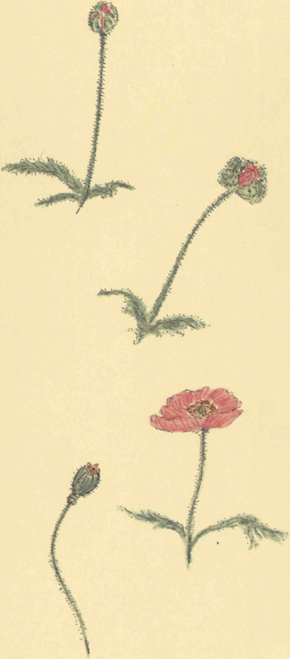
Abby had been sick in bed for over a week. Cranky, aching, and tired of being indoors, she begged me to take her outside for a walk. “Sorry, Abby,” I said, “Mom says you can’t go outside until you are 100% well.” “Oh, please, Sharon, please let’s do something different. I am so tired of looking at the same thing every day, all day long!” “You are going to do something very different today,” I replied. “You’re going to watch a flower being born.” I reached behind the door, pulled out a terra cotta pot filled with Iceland poppies, and set it on a sunny windowsill.
We read the morning away, and as we leafed through page after page of The Secret Garden, we watched a plump, hairy poppy bud slowly split, showing traces of orange along the seams. Then, quietly, almost sneaking by us, the pod fell away. During the next two hours we watched as the papery, orange petals unfurled and the wrinkles disappeared. I think that I was as excited and as touched by the poppy’s birth as Abby was. I left the pot of poppies with her and every day she called me to give me a “poppy progress report”.
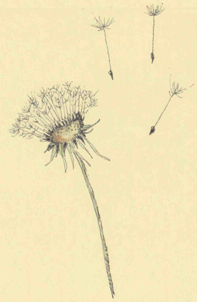
Millie Heath told me, “Every child knows how to tell the time by a dandelion clock. You blow as hard as you can, and you count each of the puffs left. An hour to a puff.” (Dandelion clocks tell fairy time.)
It has been said that each of the tiny, feathery “clocks” on a dandelion has the power to tell time, divine emotions, and sail secret, winged messages to a loved one’s soul.
Boys and girls of a hundred years ago picked “old man” dandelions, turned toward the direction of their faraway love, and blew once. If a single feathery seed remained, they knew they were not forgotten.
When children wanted to find out how many children they would someday have, they would pick a dandelion puff, close their eyes, and blow. If ten seeds remained, it foretold a large family!
From Dandelion Clocks and Other Tales by Julia Horatia Ewing London, 1894.
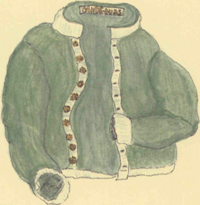
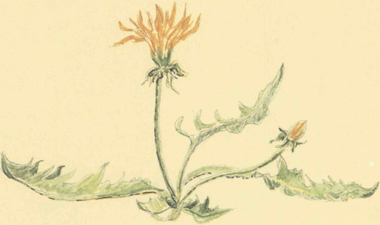
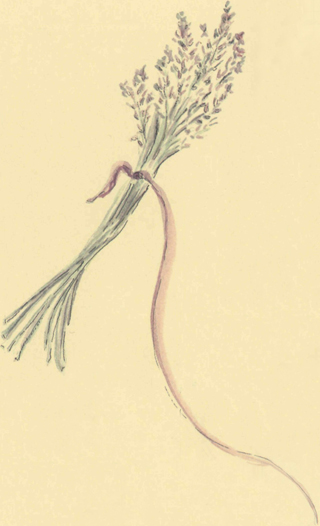
There’s nothing else like the scent of sweet lavender—fresh and clean straight from the garden in summer, or hauntingly nostalgic among the linens in winter. Lavender wands are so simple for children to make, and such a welcome gift for grandma or an older friend. Here’s a story about lavender wands told to me years ago by a customer at Heart’s Ease.
“Do you know I still have a lavender wand—sometimes we called them lavender cages—that I made over fifty years ago?” she said. “I keep it in a drawer and when I run across it I feel a whole flood of garden memories washing over me.
“Grandma would take us out into her cottage garden in the early morning as she cut her flowers and herbs for the day. I can still feel the warmth of the sun and I swear I can smell the lavender and the pinks. We would pick a handful of lavender and tie the heads together. Then, we would bend the stems back over the tied heads and tie them together—it looked like a little bottle. In fact, I think my neighbor called them bottles.
“Grandma would give us bits of ribbon from her sewing basket and we loved to weave the ribbon over and under the lavender stems. After the lavender wands were thoroughly dry we wrapped them in tissue paper and were so proud to give them to our schoolmistress the first day of school. We always had plenty to give as Christmas gifts too.”
To make a lavender wand, pick an odd number of stalks in full bud, just before the flowers start to open all the way. Thirteen or fifteen stalks makes a nice fat wand. Bundle the stalks together and tie them firmly just below where the buds start. Holding the bundle with the stems pointing upward, carefully bend each stem down so that the buds are enclosed in a little “cage” of stems. Tie the stems together with ribbon just below the enclosed cluster of buds, or use a long piece of ribbon to weave over and under the stems, making a little basket to contain the buds.
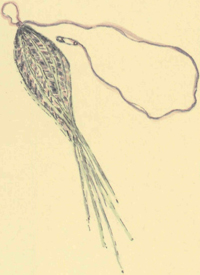
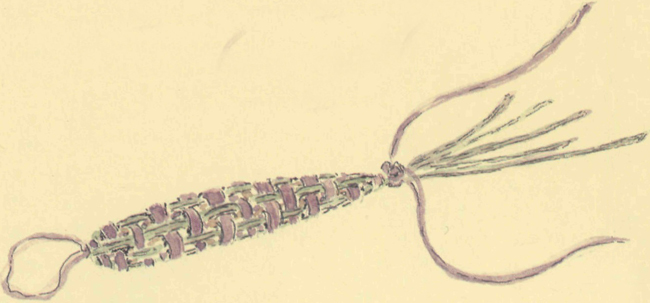
During the past years the “grown-up kids” I have interviewed have often mentioned jewelweed. This plant seems to be one that tickles the dickens in all of us. I had my first experience with jewelweed at Audubon Camp in Maine. We were hiking the Roger Tory Peterson Bird Trail skirting a large pond. One of the men on the hike asked me if I liked jewelweed. I told him that I had never run into it and would love to look at it with my magnifier.
He pulled me over to a bush covered with beautiful yellow-spurred flowers spotted with red. Hanging from a fragile stem, swaying gently in the breeze, it was easy to see why these would be called jewelweed. Crouching over a blossom, not touching it, I looked up and asked why it was called “touch-me-not”, too. My friend grinned from ear to ear, stretched his hand out to touch the flower, and ZING…like a firecracker exploding, seeds flew in all directions.
My question was answered and although I don’t like to admit it, I did enjoy touching the “snapweed” all the rest of our hike. Sure feels good acting like an irrepressible kid again! I might mention that at least a dozen other “adults” on our hike were doing the same thing.
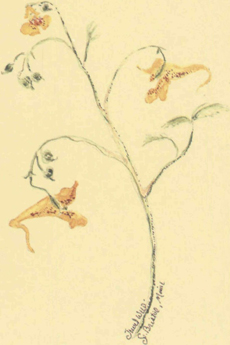
You would think that the lovely, fragile violet would be the last thing a young boy would use to have a battle, wouldn’t you? It was with a reluctant head shake and grin that Thomas Stanley related to me the violet tug-of-wars he fought in Shelbyville, Kentucky in the early 1900s.
“We would go out to the woods and pick a bunch of violets,” he said. “You know that little hook they have on them where the petals are? Well, we would try to hook each other and see who could snag a violet head and rip it off. Whoever amassed the most violet heads was the winner of the violet tournament.”
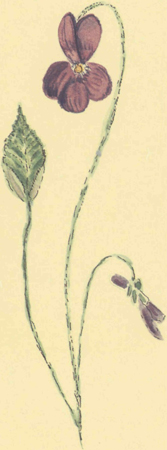
Every spring, at the mossy base of my old sundial, a small miracle quietly unfolds. First, slender spears of green, then the heart-shaped leaves of old-fashioned violets appear. Amongst the violets another leaf shape emerges almost unnoticed. And one day, without fanfare, a fragile wand of parading bleeding hearts (Dicentra spectabilis) sways gently above my violets.
In my garden I can always calculate the degree of child left in a person by how they respond to my bleeding hearts. The true measure is the excited cry of joy and recognition when they notice the hearts. Then, the almost-instantaneous kneeling and close examination of the dangling flowers. I find that the only difference between the child of eight and the child of eighty is how long it takes to rise from that kneeling position!
Bleeding hearts are one of the most loved of the old-fashioned garden flowers. So many stories have been told to me about how the flowers were hung over ears as earrings, woven into hair as a dancing heart tiara, or dissected to reveal a lady-in-a-bathtub or a man-in-a-gondola.
My favorite is the story of the beautiful Princess Dicentra who wandered away from her walled garden and became lost in the darkness of an ancient forest. The princess fell prey to an evil crone angered to have her privacy disturbed. In an instant, Di was reduced to a fraction of her normal size and entrapped in the satiny pink folds of an oddly-shaped flower.
The old crone cackled happily and told Di that she was to remain forever imprisoned unless discovered and released by an innocent youngling.
Little did the crone know how tempting the Princess would be to any passing child! Only three days passed before a party of riders stopped for water in the forest. Drinking from a stream on bended knee, a boy glanced up, spied the dancing wand tipped by a pink and white heart, and plucked it (as innocent children will do). Short, plump fingers folded back Di’s voluminous pink skirt, and the lovely princess was saved!
Dicentra is the perfect pressed flower. Picked early in the morning (after the dew has dried) and tucked between the pages of a thick dictionary, bible, or phone book, the flower is soon transformed into a perfect flat, papery little heart. After a few weeks of drying the bleeding hearts can be glued on greeting cards, valentines, or placecards for a special garden party.
The true
measure is the
excited cry of
joy and
recognition
when they
notice the
hearts.

